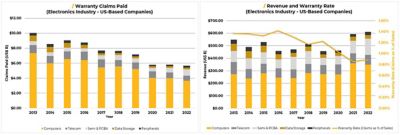-
United States -
United Kingdom -
India -
France -
Deutschland -
Italia -
日本 -
대한민국 -
中国 -
台灣
-
-
产品组合
查看所有产品Ansys致力于通过向学生提供免费的仿真工程软件来助力他们获得成功。
-
ANSYS BLOG
January 26, 2024
A Guide to Warranty Cost: How to Minimize Future Warranty Claims
Whether you are a product line manager who deals with returns and repairs or a chief financial officer (CFO) who watches warranty costs consume your bottom line every quarter, you want to reduce warranty costs. While it's not realistic to expect zero warranty costs, there are ways to minimize the frequency and impact of warranty claims.
Examine the Electronics Industry
In 2022, the U.S. electronics industry paid more than $5.5 billion in warranty claims. That may seem like a lot, but this number is down over 40% in the last 10 years while revenues have grown more than 11%. Warranty rates (i.e., claims as a percentage of sales) have fallen to near historic lows. The figure below illustrates the results achieved by the industry over the last 10 years.

Increasing product reliability and better warranty management practices have paid off for the U.S. electronics industry.
Look for a Partner, Not Just a Product
Over the last 18 years, Ansys Reliability Engineering Services (RES) has helped thousands of electronics companies identify and resolve product reliability issues.
If you want to improve product reliability, follow the steps taken by companies that have been successful:
- Have a reliability physics mindset: Reliability physics analysis (RPA) seeks to understand the physics behind what causes products to fail. Successful implementation of the approach requires investigation (through simulation, test, research, etc.) and an understanding of how the use environment will affect product, subassembly, and component reliability. Use environments may include burn-in, in-circuit test, storage, shipping, and operational use in the field. Organizations that apply RPA principles throughout the product development cycle understand the failure risks and likely failure mechanisms of their product in the design phase and can eliminate root cause or mitigate the impact of failure on the end user.
- Simulate early on: Engineering simulation enables companies to close the gap between design and reality. Integrating simulation into the design process with well-defined material properties and an understanding of the use environment — which are also critical for success in RPA — allows engineers to virtually test their ideas before committing to a design freeze. Adopting simulation early helps companies drastically reduce design iterations, prototypes, and testing while also avoiding costly failures in production, qualification, or the field. Tight coupling of simulation and design enables companies to identify and eliminate product weak points before production and delivery to the end user.
- Use a Design for Excellence (DfX) approach to design: DfX is a systematic and proactive approach to design that uses the knowledge and experience of experts in other parts of the product development process (e.g., test, manufacturing, logistics, operations, and support) to ensure the final product can be realized at reasonably low life cycle cost while still meeting reliability, quality, durability, and customer expectation targets. DfX practitioners often tout the cost savings and faster time to market achieved, but the focus on designing a product that will flow reliably through all phases of its life cycle yields lower field failure and warranty return rates.
- Incorporate reliability-centered design reviews: Every product design team performs periodic design reviews, but are they focusing on the right things? Design reviews typically focus on things like compliance to performance and functional requirements, regulations, industry standards, and design rules. All of these are important considerations. Reliability-centered design reviews are specifically focused on ensuring a product will meet or exceed its reliability goals. That is, will the product perform its intended function for the intended period of time in its likely use environment? Answering these questions and taking action to resolve issues before hitting critical design milestones ensures that reliability is designed into the product, rather than resorting to finding and fixing reliability issues during production, qualification, burn-in, or investigation of warranty returns. For more information, view the brochure “The Definitive Guide to an Electronic Assembly Design Review.”
- Conduct thorough root-cause analysis: Despite a company’s best efforts, products still fail unexpectedly. In addition to the useful design practices discussed above, good screening prior to testing, production, and delivery helps prevent product warranty returns. However, at some point in a product’s life, you will have to figure out why it failed. Finding the crack, short, or other damage that caused the product to stop working is just the beginning of the failure analysis, rather than the end. The best failure analysts apply a reliability physics mindset to determine how the environment caused the damage observed (i.e., the failure mechanism), and how that damage caused the product to fail as it did (i.e., the failure mode). Understanding the physics behind the failure allows companies to find and eliminate true root causes and make more informed decisions about how to implement redesign, repair, maintenance, or other mitigations to reduce further failures, and warranty returns. Read “Ansys Reliability Engineering Services Team Identifies Root Cause of Failure for Electronics Manufacturer” for more information.
Whether you are an original equipment manufacturer (OEM) or supplier of electronics, you can benefit from the hard-won lessons of others in the industry. Contact the Ansys Reliability Engineering Services (RES) team to put decades of electronics reliability expertise to work for you and improve the reliability of your product.










